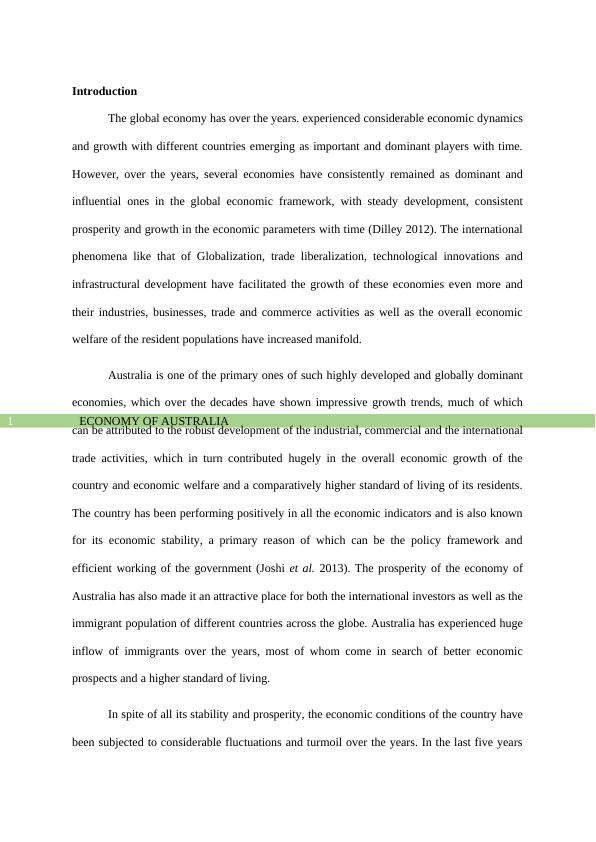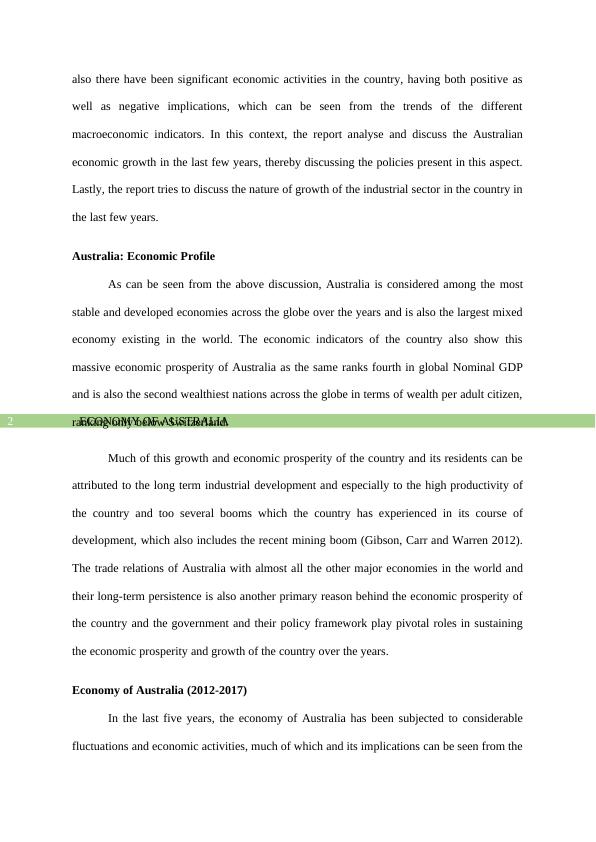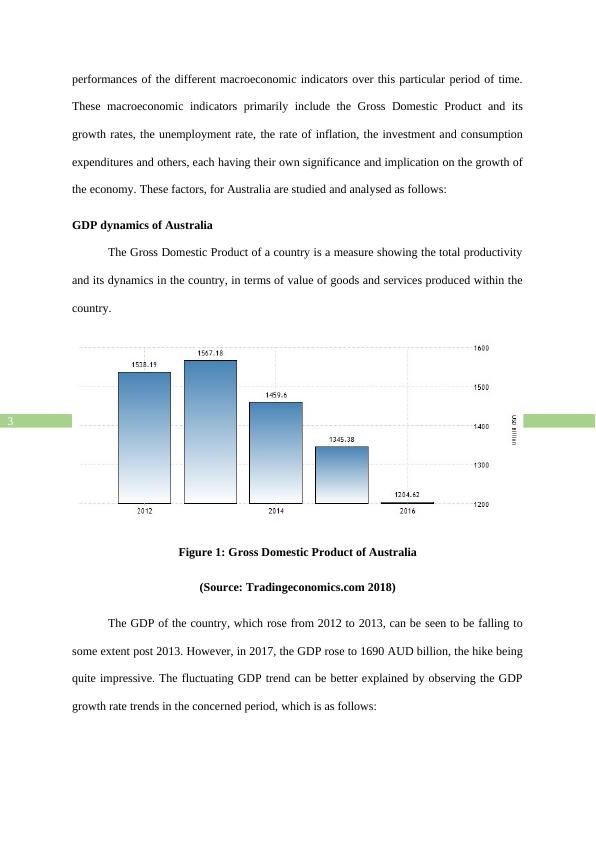Economy of Australia - Assignment
18 Pages3584 Words41 Views
Added on 2021-06-17
Economy of Australia - Assignment
Added on 2021-06-17
ShareRelated Documents
Running head: ECONOMY OF AUSTRALIA
Economy of Australia
Name of the Student
Name of the University
Author Note
Economy of Australia
Name of the Student
Name of the University
Author Note

ECONOMY OF AUSTRALIA1
Introduction
The global economy has over the years. experienced considerable economic dynamics
and growth with different countries emerging as important and dominant players with time.
However, over the years, several economies have consistently remained as dominant and
influential ones in the global economic framework, with steady development, consistent
prosperity and growth in the economic parameters with time (Dilley 2012). The international
phenomena like that of Globalization, trade liberalization, technological innovations and
infrastructural development have facilitated the growth of these economies even more and
their industries, businesses, trade and commerce activities as well as the overall economic
welfare of the resident populations have increased manifold.
Australia is one of the primary ones of such highly developed and globally dominant
economies, which over the decades have shown impressive growth trends, much of which
can be attributed to the robust development of the industrial, commercial and the international
trade activities, which in turn contributed hugely in the overall economic growth of the
country and economic welfare and a comparatively higher standard of living of its residents.
The country has been performing positively in all the economic indicators and is also known
for its economic stability, a primary reason of which can be the policy framework and
efficient working of the government (Joshi et al. 2013). The prosperity of the economy of
Australia has also made it an attractive place for both the international investors as well as the
immigrant population of different countries across the globe. Australia has experienced huge
inflow of immigrants over the years, most of whom come in search of better economic
prospects and a higher standard of living.
In spite of all its stability and prosperity, the economic conditions of the country have
been subjected to considerable fluctuations and turmoil over the years. In the last five years
Introduction
The global economy has over the years. experienced considerable economic dynamics
and growth with different countries emerging as important and dominant players with time.
However, over the years, several economies have consistently remained as dominant and
influential ones in the global economic framework, with steady development, consistent
prosperity and growth in the economic parameters with time (Dilley 2012). The international
phenomena like that of Globalization, trade liberalization, technological innovations and
infrastructural development have facilitated the growth of these economies even more and
their industries, businesses, trade and commerce activities as well as the overall economic
welfare of the resident populations have increased manifold.
Australia is one of the primary ones of such highly developed and globally dominant
economies, which over the decades have shown impressive growth trends, much of which
can be attributed to the robust development of the industrial, commercial and the international
trade activities, which in turn contributed hugely in the overall economic growth of the
country and economic welfare and a comparatively higher standard of living of its residents.
The country has been performing positively in all the economic indicators and is also known
for its economic stability, a primary reason of which can be the policy framework and
efficient working of the government (Joshi et al. 2013). The prosperity of the economy of
Australia has also made it an attractive place for both the international investors as well as the
immigrant population of different countries across the globe. Australia has experienced huge
inflow of immigrants over the years, most of whom come in search of better economic
prospects and a higher standard of living.
In spite of all its stability and prosperity, the economic conditions of the country have
been subjected to considerable fluctuations and turmoil over the years. In the last five years

ECONOMY OF AUSTRALIA2
also there have been significant economic activities in the country, having both positive as
well as negative implications, which can be seen from the trends of the different
macroeconomic indicators. In this context, the report analyse and discuss the Australian
economic growth in the last few years, thereby discussing the policies present in this aspect.
Lastly, the report tries to discuss the nature of growth of the industrial sector in the country in
the last few years.
Australia: Economic Profile
As can be seen from the above discussion, Australia is considered among the most
stable and developed economies across the globe over the years and is also the largest mixed
economy existing in the world. The economic indicators of the country also show this
massive economic prosperity of Australia as the same ranks fourth in global Nominal GDP
and is also the second wealthiest nations across the globe in terms of wealth per adult citizen,
ranking only below Switzerland.
Much of this growth and economic prosperity of the country and its residents can be
attributed to the long term industrial development and especially to the high productivity of
the country and too several booms which the country has experienced in its course of
development, which also includes the recent mining boom (Gibson, Carr and Warren 2012).
The trade relations of Australia with almost all the other major economies in the world and
their long-term persistence is also another primary reason behind the economic prosperity of
the country and the government and their policy framework play pivotal roles in sustaining
the economic prosperity and growth of the country over the years.
Economy of Australia (2012-2017)
In the last five years, the economy of Australia has been subjected to considerable
fluctuations and economic activities, much of which and its implications can be seen from the
also there have been significant economic activities in the country, having both positive as
well as negative implications, which can be seen from the trends of the different
macroeconomic indicators. In this context, the report analyse and discuss the Australian
economic growth in the last few years, thereby discussing the policies present in this aspect.
Lastly, the report tries to discuss the nature of growth of the industrial sector in the country in
the last few years.
Australia: Economic Profile
As can be seen from the above discussion, Australia is considered among the most
stable and developed economies across the globe over the years and is also the largest mixed
economy existing in the world. The economic indicators of the country also show this
massive economic prosperity of Australia as the same ranks fourth in global Nominal GDP
and is also the second wealthiest nations across the globe in terms of wealth per adult citizen,
ranking only below Switzerland.
Much of this growth and economic prosperity of the country and its residents can be
attributed to the long term industrial development and especially to the high productivity of
the country and too several booms which the country has experienced in its course of
development, which also includes the recent mining boom (Gibson, Carr and Warren 2012).
The trade relations of Australia with almost all the other major economies in the world and
their long-term persistence is also another primary reason behind the economic prosperity of
the country and the government and their policy framework play pivotal roles in sustaining
the economic prosperity and growth of the country over the years.
Economy of Australia (2012-2017)
In the last five years, the economy of Australia has been subjected to considerable
fluctuations and economic activities, much of which and its implications can be seen from the

ECONOMY OF AUSTRALIA3
performances of the different macroeconomic indicators over this particular period of time.
These macroeconomic indicators primarily include the Gross Domestic Product and its
growth rates, the unemployment rate, the rate of inflation, the investment and consumption
expenditures and others, each having their own significance and implication on the growth of
the economy. These factors, for Australia are studied and analysed as follows:
GDP dynamics of Australia
The Gross Domestic Product of a country is a measure showing the total productivity
and its dynamics in the country, in terms of value of goods and services produced within the
country.
Figure 1: Gross Domestic Product of Australia
(Source: Tradingeconomics.com 2018)
The GDP of the country, which rose from 2012 to 2013, can be seen to be falling to
some extent post 2013. However, in 2017, the GDP rose to 1690 AUD billion, the hike being
quite impressive. The fluctuating GDP trend can be better explained by observing the GDP
growth rate trends in the concerned period, which is as follows:
performances of the different macroeconomic indicators over this particular period of time.
These macroeconomic indicators primarily include the Gross Domestic Product and its
growth rates, the unemployment rate, the rate of inflation, the investment and consumption
expenditures and others, each having their own significance and implication on the growth of
the economy. These factors, for Australia are studied and analysed as follows:
GDP dynamics of Australia
The Gross Domestic Product of a country is a measure showing the total productivity
and its dynamics in the country, in terms of value of goods and services produced within the
country.
Figure 1: Gross Domestic Product of Australia
(Source: Tradingeconomics.com 2018)
The GDP of the country, which rose from 2012 to 2013, can be seen to be falling to
some extent post 2013. However, in 2017, the GDP rose to 1690 AUD billion, the hike being
quite impressive. The fluctuating GDP trend can be better explained by observing the GDP
growth rate trends in the concerned period, which is as follows:

End of preview
Want to access all the pages? Upload your documents or become a member.
Related Documents
Assignment on Economics (PDF)lg...
|18
|3854
|20
Economy of Australia: GDP, Inflation, Unemployment, Trade Volumes and Policy Structurelg...
|18
|3856
|168
Economy of Australia - Assignmentlg...
|25
|4500
|66
Economic Growth and Policy Framework of Australia (2012-2017)lg...
|22
|4241
|145
(PDF) Economics Assignment Solutionlg...
|21
|3736
|31
Unemployment Trends in Australia: A Five-Year Analysislg...
|14
|3484
|148
